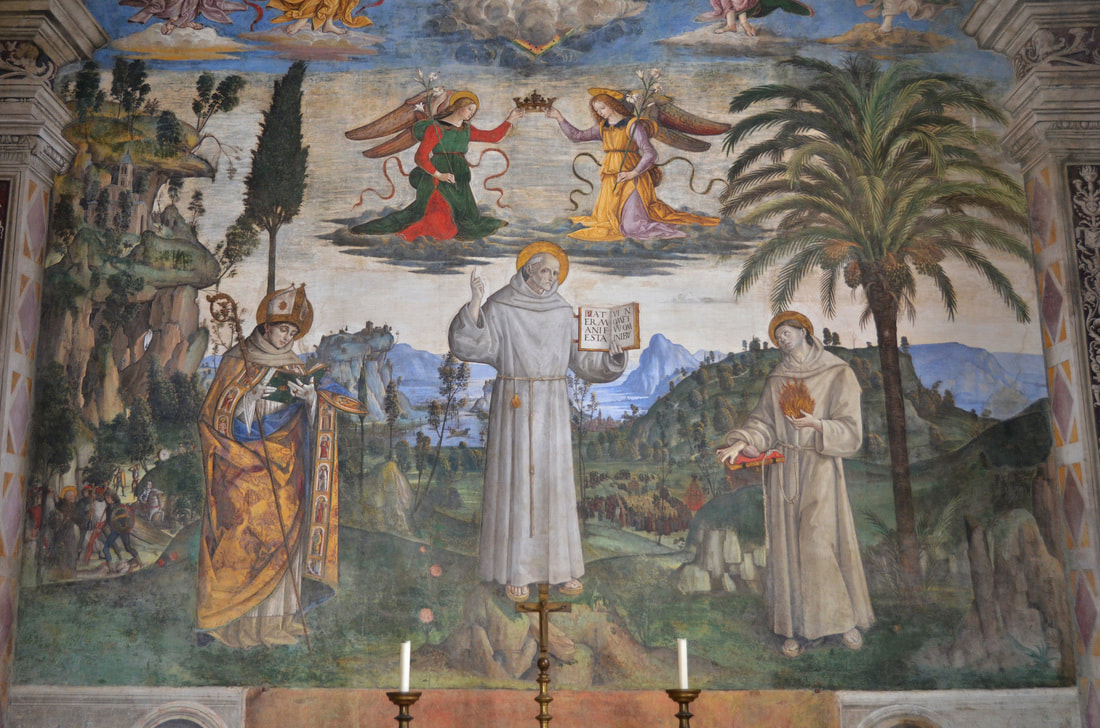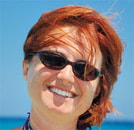Tourists always ask me if these are the famous Spanish steps.
Well, no, they are not. This is the stairway leading to a beautiful church and is worth visiting.
Here on the Capitoline hill, there used to be the temple of Juno and the geese sacred to the Goddess, which gave the alarm to the city during the attack of the Gauls, 'monere' in Latin means to warn someone. The Goddess was patronizing the money issue, called 'moneta,' thanks to the warning Juno.
Well, no, they are not. This is the stairway leading to a beautiful church and is worth visiting.
Here on the Capitoline hill, there used to be the temple of Juno and the geese sacred to the Goddess, which gave the alarm to the city during the attack of the Gauls, 'monere' in Latin means to warn someone. The Goddess was patronizing the money issue, called 'moneta,' thanks to the warning Juno.
| According to the legend, the church was built on the place where the Emperor Octavian Augustus saw in a dream the Madonna with the baby Jesus and Mary told him, pointing the Capitoline hill: 'this is the altar of the son of God'; another version of the same story says that the Sybil of Tivoli explained to him the vision. The stairs were built as a thank-giving to God after a plague, and it is quite hard to climb them. |
Therefore I would recommend accessing the church from its back, climbing the nearby Michelangelo Cordonata stairway, reaching the back side of the church, around the corner of the Capitoline Museums, and climbing the stairs you see in the photo on the right.
Once Benedictine, the church was assigned to the Franciscans.
Inside the church, look at the Bufalini Chapel on the first Chapel to the right aisle. The Chapel honors the Franciscan saint San Bernardino from Siena, famous for his qualities as a preacher. He gave a famous sermon also in Rome at the foot of the stairs in a market once held in this area. He said vibrant words against gambling and cheating with card games.
In the painting below, the painter Pinturicchio represents Bernardino in the middle. On his right, you find St Anthony, and on the left, St. Augustine. In the book that Bernardino holds in his hands, you can find a Latin sentence, 'Father, you showed your name to everybody,' which refers to the abbreviation of Christ 'IHS' that Bernardino invented for which he was accused of heresy. This abbreviation later became the symbol of the Jesuit order.
Once Benedictine, the church was assigned to the Franciscans.
Inside the church, look at the Bufalini Chapel on the first Chapel to the right aisle. The Chapel honors the Franciscan saint San Bernardino from Siena, famous for his qualities as a preacher. He gave a famous sermon also in Rome at the foot of the stairs in a market once held in this area. He said vibrant words against gambling and cheating with card games.
In the painting below, the painter Pinturicchio represents Bernardino in the middle. On his right, you find St Anthony, and on the left, St. Augustine. In the book that Bernardino holds in his hands, you can find a Latin sentence, 'Father, you showed your name to everybody,' which refers to the abbreviation of Christ 'IHS' that Bernardino invented for which he was accused of heresy. This abbreviation later became the symbol of the Jesuit order.
On the left side of the chapel, you can find the funerals of St. Bernardino, set in a beautiful renaissance urban prospective. On the left is the man who paid for the paintings, an employer of the Papal court, Riccomanno Bufalini, holding a glove in his hand and wearing a rich mantel with fur. All around the main image, you can see the different miracles of the saint. In the center, the Franciscan with the head covered is probably the prior of the church at the time of the paintings, and he appears again on the right wall of the chapel, through a window, with his brothers in faith.
Two years ago, I had the pleasure to guide in Rome an Italian group from San Giustino, Città di Castello, from where Riccomanno Bufalini came from. The group was one of the nicest I had that year, and they requested to see their famous ancient citizen in this chapel.
After visiting the church, we took a coffee at the café just outside the church on the Victor Emmanuel II monument. We took the elevator in this monument to appreciate the view over Rome.
The group invited me then to San Giustino, where the Bufalini castle can be visited. They brought me some brochures of the castle and, I promise, sometimes I will certainly go to see it and enjoy the warmth of the San Giustino people.
Two years ago, I had the pleasure to guide in Rome an Italian group from San Giustino, Città di Castello, from where Riccomanno Bufalini came from. The group was one of the nicest I had that year, and they requested to see their famous ancient citizen in this chapel.
After visiting the church, we took a coffee at the café just outside the church on the Victor Emmanuel II monument. We took the elevator in this monument to appreciate the view over Rome.
The group invited me then to San Giustino, where the Bufalini castle can be visited. They brought me some brochures of the castle and, I promise, sometimes I will certainly go to see it and enjoy the warmth of the San Giustino people.
ther information contact me at infoIn the Church, you can also find a column with a hole through it (near the façade on the left aisle). The legend says that it comes from the house of Octavian Augustus, and a light going through the column woke him when he had the vision of the Virgin Mary.
Secondly, suppose you reach the counter façade of the Church. In that case, the tomb of Giovanni Crivelli is on the floor. It is now repositioned vertically on the wall, created by Donatello, the famous Florentine sculpture, and signed by the artist.
Moreover, there used to be a small statue of Jesus in a small transept chapel, beloved by the Romans, which was stolen a few years ago and now replaced by a copy. For centuries, when a baby was born in Rome, people used to say he was as beautiful as the Jesus of the Aracoeli.
Tips:
-Access the Victor Emanuel Monument II and the Church from the back, Piazza del Campidoglio.
-The elevator of the Victor Emmanuel Monument costs 7 euros, but the view is also amazing from the lower levels, which are free. Go all around the outer parts of the building.
-Leaving the Church, on the via di Aracoeli 14, there is a good bakery which makes lovely sandwiches, Mozzarellamania, no seats available inside though. Good ice cream shop next door, Vacanze Romane, on the same street. If you need to sit down and rest in a restaurant, reach the nearby Jewish district short cutting from the Theatre of Marcellus. On via del Portico d'Ottavia, you have plenty of good restaurants offering Jewish-Roman cuisine.
-If you are going to Umbria during your trip, visit the San Giustino castle: http://www.castellobufalini.beniculturali.it/index.php?lang=eng
If you need further information contact me at [email protected]
Secondly, suppose you reach the counter façade of the Church. In that case, the tomb of Giovanni Crivelli is on the floor. It is now repositioned vertically on the wall, created by Donatello, the famous Florentine sculpture, and signed by the artist.
Moreover, there used to be a small statue of Jesus in a small transept chapel, beloved by the Romans, which was stolen a few years ago and now replaced by a copy. For centuries, when a baby was born in Rome, people used to say he was as beautiful as the Jesus of the Aracoeli.
Tips:
-Access the Victor Emanuel Monument II and the Church from the back, Piazza del Campidoglio.
-The elevator of the Victor Emmanuel Monument costs 7 euros, but the view is also amazing from the lower levels, which are free. Go all around the outer parts of the building.
-Leaving the Church, on the via di Aracoeli 14, there is a good bakery which makes lovely sandwiches, Mozzarellamania, no seats available inside though. Good ice cream shop next door, Vacanze Romane, on the same street. If you need to sit down and rest in a restaurant, reach the nearby Jewish district short cutting from the Theatre of Marcellus. On via del Portico d'Ottavia, you have plenty of good restaurants offering Jewish-Roman cuisine.
-If you are going to Umbria during your trip, visit the San Giustino castle: http://www.castellobufalini.beniculturali.it/index.php?lang=eng
If you need further information contact me at [email protected]




